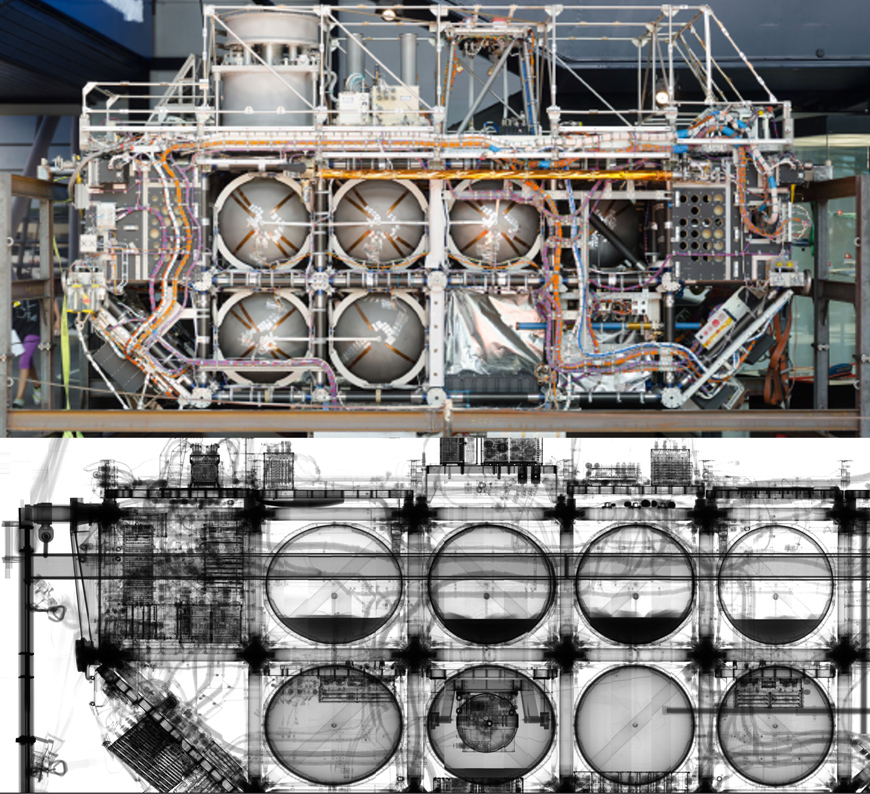EURECA examined at Empa
X-raying a satellite
It is rare for satellites to return to Earth intact after their mission in space – one example is the European satellite EURECA. Empa researchers have studied the satellite using various non-destructive X-ray methods. These could be used in future in the development of reusable space technologies, as well as in aviation and the automotive industry.

Whether it's a sprained ankle or a backpack at the airport, X-ray images are an everyday occurrence in many areas. Empa researchers at the Center for X-Ray Analytics have succeeded in taking images that are far less commonplace: In collaboration with the Swiss Space Center (now Space Innovation at EPFL) and the Swiss Museum of Transport, they have X-rayed an entire satellite.
The imaged satellite is called EURECA – short for EUropean REtrievable CArrier – and is one of a kind. It was launched into space in 1992 aboard the Space Shuttle Atlantis. Swiss astronaut Claude Nicollier deployed EURECA into orbit. There, the 4.5-ton satellite remained for the next eleven months – until it was captured by the crew of the Space Shuttle Endeavour on July 1, 1993, and brought back to Earth. This makes EURECA one of the very few satellites to have returned from its mission in space intact.

The European Space Agency (ESA) originally planned several missions for the reusable satellite. EURECA carried 15 interchangeable instruments for scientific experiments ranging from biology to astrophysics. However, the budget for the program was cut, and EURECA's first flight was also its last. At the end of 2000, the satellite was put on exhibit at the Swiss Museum of Transport in Lucerne. From there, the journey to Dübendorf and Empa was a short one. Examining a flown satellite was not an opportunity Empa researchers were willing to miss.
A deep look inside
EURECA was first X-rayed in 2016. The complete results of the investigation were published in 2025 in the journal Acta Astronautica. Using the high-energy X-ray facility, the researchers were able to X-ray the five-meter-long, three-meter-high, and two-and-a-half-meter-wide satellite in one piece. They also used other X-ray techniques for parts of the satellite and for the two scientific instruments that remained on board.
The big advantage of X-ray imaging is the same for satellites as it is for ankles in hospitals and hand luggage at airports: It allows a non-destructive view of the interior. ”Our analysis covers several orders of magnitude, from the entire carrier structure of the satellite to investigations of materials at nanometer scale,“ says Empa researcher Robert Zboray, lead author of the publication. The researchers found several defects, such as cracks in EURECA's composite struts and fractures and deformations in the scientific instruments.
“Satellites are exposed to strong radiation, large temperature fluctuations, and collisions with particles from meteorites and space debris,” says Zboray. “Our methods enable us to identify weak points, especially in reusable satellites.” Damage can also occur during launch and landing. According to Zboray, further experiments would be necessary to pinpoint the exact event that caused the damage. “Ideally, such satellites should be X-rayed both before launch and after landing,” says the scientist.
Although these days, EURECA only unfolds its solar panels at the Swiss Museum of Transport, the topic of reusable space technologies is more relevant today than ever before. By 2025, there will be over 10,000 satellites in Earth's orbit – and the number is growing every year. The issue is compounded by countless rocket stages, fragments of old satellites, and other space debris that pose a danger to active satellites and manned spaceflight. Reusable satellites could help reduce this flood of space junk – and Zboray is convinced that X-ray techniques could be used to optimize their design. However, high-energy X-ray imaging also has terrestrial applications, such as examining components for the aviation and automotive industries, or even in forensics.
PD Dr. Robert Zboray
Empa, Center for X-ray Analytics
Phone +41 58 765 46 02
R Zboray, C Roeoesli, A Flisch, M Plamondon, R Kaufmann, C von Deschwanden, K Zweiacker, T Lüthi, T Bandi, G Bourban, V Gass, D Amstutz, A Dommann, A Neels: Multi-scale and multi-energy non-destructive X-ray analysis of the European Retrievable Carrier (EURECA); Acta Astronautica (2025); doi: 10.1016/j.actaastro.2025.05.042
Space technologies
Empa's research is conquering space. From components for space probes and imaging techniques for satellites to materials development on the International Space Station: Empa researchers are working on a wide range of materials and technologies for use at the “final frontier”. But no matter how high the research flies, it is still down-to-earth, as technologies for space have a variety of applications on Earth, whether for innovative electronics, medical devices, or monitoring environmental agreements.
Read the EmpaQuarterly online or download the PDF version.
-
Share






